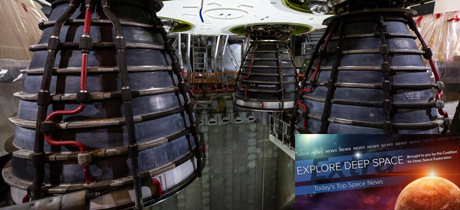In Today’s Deep Space Extra… Teams at NASA’s Kennedy Space Center working to finish preparations in time for mid-February rollout of Artemis I integrated vehicle for wet dress rehearsal. NASA astronaut corps may be too small.
Human Space Exploration
EGS, Jacobs working to finish testing in time for Artemis I rollout in mid-February
Coalition Members in the News – Boeing, Jacobs
NASAspaceflight.com (1/17): NASA’s Exploration Ground Systems (EGS) and prime contractor Jacobs are performing final installations and checkups for the Artemis I integrated Space Launch System (SLS) and Orion spacecraft in the Vehicle Assembly Building (VAB) at NASA’s Kennedy Space Center (KSC) ahead of rolling the hardware out for wet dress rehearsal no earlier than mid-February. Meanwhile, the teams are also preparing to re-run countdown sequencing tests to verify systems are ready to conduct launch countdowns for the integrated SLS and Orion vehicle. Meanwhile, functional checkouts of the SLS Core Stage Main Propulsion System (MPS) and RS-25 engines verified that they are ready to be loaded and fired, this time for launch. The functional testing was the last part of Program Specific Engineering Tests (PSET). With functional checks complete, the Core Stage engine section can now be closed out for launch over the next few weeks. “Getting that whole engine section closed out is a big milestone towards rolling out,” Cliff Lanham, NASA Senior Vehicle Operations manager for EGS at KSC, said in an interview. A decision was made to have Core Stage prime contractor Boeing perform the installation of the engine-mounted heatshield (EMHS) blankets, which is the most time-consuming task in that part of preparations.
NASA inspector general warns astronaut corps may be too small
SpaceNews.com (1/15): At 44, the number of NASA astronauts may soon fall below the minimum level the agency needs to support International Space Station (ISS) and Artemis missions, according to the agency’s inspector general (IG). According to the report, the NASA astronaut office performed a “sizing analysis” in 2019 and concluded that the corps would fall below the minimum manifest requirement in fiscal years 2022 and 2023. That analysis led to the agency’s decision to recruit a new class of astronauts, announced last month. Nevertheless, by the time the new astronauts are eligible for flight assignments in 2024, NASA will have to contend with both continued attrition of the current corps and demand for additional astronauts for Artemis missions.
Space Science
Interstellar probe proposed to explore the solar neighborhood
Sky and Telescope (1/17): Scientists from the Johns Hopkins University’s Applied Physics Lab envision the launch of a mission beyond the solar system with an Interstellar Probe, potentially in the mid-2030s. The probe would launch on a Block 2 version of a NASA Space Launch System (SLS) rocket to provide a high velocity departure for studies of the interface between the sun’s heliosphere and the interstellar medium. The prospect for the mission was discussed at the American Geophysical Union meeting in New Orleans at the end of 2021. An Interstellar Probe mission could emerge as part of the forthcoming 2023/2032 Solar and Space Physics Decadal Survey, an assessment of the highest science priorities in the solar/space physics arena.
A huge asteroid will fly safely by Earth today. Here’s how to watch it live
Space.com (1/18): The small world’s closest approach will be at 4:51 p.m. EST (2151 GMT), according to a table from the Center for Near-Earth Object Studies (CNEOS), managed by NASA at the agency’s Jet Propulsion Laboratory (JPL) in California. The distance is very safe, as the 3,400-foot (1-kilometer) asteroid will get no closer than five lunar distances during its closest approach, NASA says. The average distance from Earth to the Moon, one lunar distance, is about 238,855 miles (384,400 km).
Other News
Industry offers cautious optimism about state of space investment
SpaceNews.com (1/17): The recent and sometimes wobbly entry of Special Purpose Acquisition Corporations, or SPACs, into the space industry to raise funds and help take new ventures public has some veteran investors concerned as they head into 2022. The outlook was a topic of the SpaceCom conference in Orlando, Florida, earlier this month. One of the concerned, Eric Stallmer, executive vice president for government affairs and public policy at Voyager Space, urged a closer look at investor concerns.
Report: Nuclear propulsion would help military satellites maneuver out of harm’s way
SpaceNews.com (1/14): The Defense Advanced Research Projects Agency (DARPA) has watched NASA’s work in nuclear propulsion systems for space exploration and believes the technology can be applied to military satellites. An experiment planned by DARPA will send to orbit a spacecraft powered by a nuclear propulsion system. Michael Leahy, director of the agency’s Tactical Technology Office, said this technology could give the U.S. military an advantage over enemies by making satellites more maneuverable and less vulnerable to attack. But skepticism and fear of nuclear energy is an issue that will require more education and awareness to “get folks comfortable with this,” Leahy said January 14.

